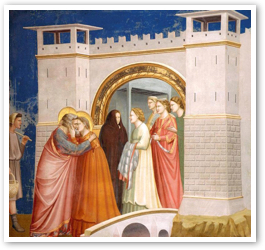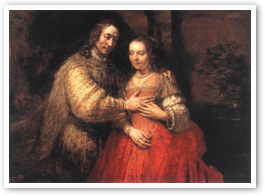Looking at a Masterpiece: Spousal Love
- MADELEINE F. STEBBINS
In a time when the world has lost the true vision of marriage, when a false and superficial vision has come to the fore, it is important through the medium of great art to dwell on what marriage really means and was meant to be.
This never fading, never outdated art opens our eyes to a deeper perception of a whole world of perennial beauty and of true happiness.
Christ called His disciples to be "the salt of the earth" (Mt 5:13). Right from the beginning Christianity dared to be counter-cultural. It proclaimed "grace seasoned with salt" and this ultimately for the sake of our happiness (Col 4:6).
What have great masterpieces in a rich tradition down through the ages told us about married love? What was the profound wisdom they visually communicated?
Here are two splendid examples which are entirely divergent in style, and centuries apart, expressing different aspects of spousal love — complimentary views within a basic unity.
The first is a detail of the fresco of "Joachim and Anna at the Golden Gate of Jerusalem" (c.1305) by Giotto (1266/7-1337) in the Scrovegni Chapel in Padua.
According to a tradition dating from the second century, the parents of Mary, Joachim and Anna, for many years begged God for a child. Giotto depicts the moment when they meet after learning that their prayers have finally been heard and that they will have a daughter.
We see a fusion of these two God-fearing souls exulting in the love of God and deeply moved by the wondrous gift of a child — and what a child! — the immaculate one, the fruit of their love. In an almost modern way (I should rather call it a timeless way), the fresco has a simplicity of lines and a paucity of means in its style without flourishes or ornamentation.
The result is intensely expressive of a union of persons melding into each other, becoming one, their hands tender and reverent, their eyes blissful and enraptured, so close that the image is almost that of one face (as though the two had become one flesh). Giotto conveys something godly, something sacred in their matrimonial love. One senses that through their child God is in their midst and almost tangibly present to them.
The second masterpiece, called "The Jewish bride" or "The Bridal Couple" (c.1667) by Rembrandt van Rijn (1606-1669), hangs in the Rijksmuseum in Amsterdam. Possibly it represents an Old Testament couple such as Isaac and Rebecca.¹
There is hardly a painting which so truly expresses the inner glow of tenderness in spousal love. It is how God in His creative providence wants spousal love to be. The bridegroom loves, honors, and protects his bride as shown in the particularly reverent gesture of his hands, reverence being the key to genuine romance. Reverence here means profound respect tinged with awe. His right hand is softly held over her heart as if listening to her.² Far from exercising any kind of domination, his vocation is to be her protector. His posture is manly and chivalrous. His face shows that he cherishes her as a precious person. His arms, clothed in an iridescent gold fabric, are like the setting for a treasured jewel and like a circle around their tender and intimate union.
She represents being and receptivity. One can say she is destined to embody what Dietrich von Hildebrand called the "apostolate of being," that is, to radiate grace, love.³ Her being has luster and mystery, a faint blush in her cheeks is visible. An interior warmth appears under the surface of her gentle and beautiful modesty.4 This is also expressed in the bright, nuanced scarlet color of her dress, suggesting the love of her heart, and the glow of a hearth. Both spouses lean slightly towards each other in trust. Each with a different manly or womanly character receives the other as an incomparable gift, and each gives him or herself freely and totally to the other.
This is the image of true spousal love, authentic and enduring.
1. Duncan Bull et al., Rembrandt- Caravaggio, Rijksmuseum (Amsterdam, 2006) p.131 (Wikipedia).
2. "Every inch of the canvass is fascinating. Most moving of all is the diffident tenderness with which the man lays his hand on the woman's breast and she responds to the caress with the lightest touch of her fingertips. This is love made absolute. . . . [This painting] is in my opinion one of the most beautiful pictures in the world." Bob Haak (former curator of the Rijksmuseum), Rembrandt (Harry N. Abrams, Inc. New York) 1969, p. 322.
3. Alice von Hildebrand, Man and Woman: A Divine Invention (Sapientia Press, 2010) p. 49.
4. "typically female gems: gentleness, empathy, warmth, devotion and mystery." Ibid, p.11.
 This is Meaghen Gonzalez, Editor of CERC. I hope you appreciated this piece. We curate these articles especially for believers like you.
This is Meaghen Gonzalez, Editor of CERC. I hope you appreciated this piece. We curate these articles especially for believers like you.
Please show your appreciation by making a $3 donation. CERC is entirely reader supported.

Acknowledgement
 Madeleine Stebbins. "Looking at a Masterpiece: Spousal Love." Lay Witness (January/February 2014).
Madeleine Stebbins. "Looking at a Masterpiece: Spousal Love." Lay Witness (January/February 2014).
Reprinted with permission of Lay Witness magazine.
Lay Witness is a publication of Catholic United for the Faith, Inc., an international lay apostolate founded in 1968 to support, defend, and advance the efforts of the teaching Church.
The Author
Madeleine Stebbins, widow of CUF founder H. Lyman Stebbins, is the chairman of CUFs board of directors.
Copyright © 2014 Lay Witness





